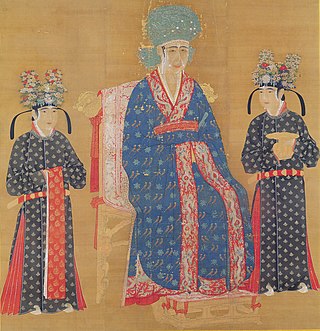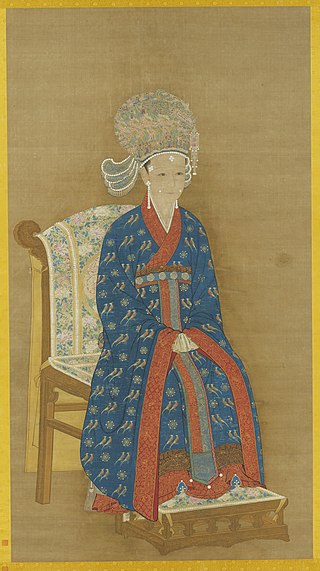Related Research Articles
Madame Ke, was the wet nurse of the Tianqi Emperor (1605–1627), and known for her great influence during his reign as emperor of the Ming dynasty from 1620 to 1627.
Empress Yi'an (1606–1644), of the Zhang clan, was the empress consort of the Tianqi Emperor of the Chinese Ming dynasty.

Empress Xiaojiesu (1508–1528), of the Chen clan, was a Chinese empress consort of the Ming dynasty, first empress to the Jiajing Emperor.

Empress Cao was a Chinese empress consort of the Song dynasty, married to Emperor Renzong of Song. She served as regent of China during the illness of Emperor Yingzong, from 1063 until 1064.

Empress Meng was a daughter of Meng Yuen and the Chinese empress consort of the Song dynasty, married to Emperor Zhezong of Song. She served as a regent of China in 1127, and during the minority of Emperor Zhang, the son of Emperor Gaozong of Song, who was temporarily placed upon the throne for 25 days in 1129. She played a significant political role in Chinese politics: first by legitimizing the Da Chu dynasty in 1127, and then ending it by legitimizing Emperor Gaozong of Song as the heir of the Song dynasty.
Empress Quan (1241–1309), was a Chinese empress consort of the Song dynasty, married to Emperor Duzong of Song.
Empress Hu, personal name Hu Shanxiang, was a Chinese empress consort of the Ming dynasty, married to the Xuande Emperor. She was posthumously honoured with the title Empress Gongrangzhang.
Danashiri was an empress consort of the Yuan dynasty, married to Toghon Temür.

Empress Wu was a Chinese empress consort of the Song dynasty, married to Emperor Gaozong of Song. She played an influential part in politics of the Southern Song dynasty for 35 years having caused the abdication of three subsequent monarchs: Emperor Gaozong in 1162, Emperor Xiaozong in 1189, and Emperor Guangzong in 1194.
Empress Xing, personal name Xing Shi, was a Chinese empress of the Song dynasty, married to Emperor Gaozong of Song.

Li Fengniang, posthumously honored as Empress Ciyi, was a Chinese empress consort of the Song dynasty, married to the Emperor Guangzong of Song. She was as the de facto ruler of the Song dynasty during the reign of her spouse.
Bao Junhui was a late eighth-century Chinese poet. She came from a respected family during the Tang dynasty and achieved fame as a poet during the reign of Emperor Dezong (779-804).
Cao Exiu, was a Chinese actress and poet.
Fu Daokun, was a Chinese painter during the Ming Dynasty. She was famed foremost for her skill as a copyist and her technique in Chinese Painting. She was, together with Fan Daokun, one of only two female artists to be recognized by her contemporaries as elite artists.
Song Ruoxian, was a Chinese Confucian scholar and poet. She was one of five sisters, who all became employed as official poets at the Imperial court: Song Ruoshen, Song Ruozhao, Song Ruoxian, Song Ruolun (宋若倫) and Song Ruoxun (宋若荀). She was the third eldest of the sisters.
Ruyuan was a Chinese Buddhist abbess and master, lüshi.
Tianranxiu was a Chinese actress of the zaju theater.She is also a courtesan.She was described as a great beauty and regarded as a national treasure in contemporary China, praised for her roles as heroine and as female members of the Imperial family, and counted Bai Pu and Li Gaizhi among her admirers.
Chen Poxi (14th-century) was a Chinese tanchang-singer and musician.
Guan Daogao was a Chinese calligrapher, poet, and painter who lived during the Yuan Dynasty. She was born in Qixian, Wuxing. She is known for the Avolokitesvara Saddarapundarika Sutra.
Concubine Guo, personal name Guo Ai, courtesy name Shanli (善理), was a concubine of Xuande Emperor.
References
- Lily Xiao Hong Lee, Sue Wiles: Biographical Dictionary of Chinese Women, Volume II: Tang Through Ming 618 - 1644
- 1 2 Xu, Sufeng (2006-01-01). "The Rhetoric of Legitimation: Prefaces to Women's Poetry Collections from the Song to the Ming". NAN NÜ. 8 (2): 255–289. doi:10.1163/156852606779969798. ISSN 1387-6805.
- 1 2 The Quest for Gentility in China: Negotiations Beyond Gender and Class. Routledge. ISBN 978-1-134-07704-5.
- 1 2 Lee, Lily Xiao Hong; Wiles, Sue (2015-01-28). Biographical Dictionary of Chinese Women, Volume II: Tang Through Ming 618 - 1644. Routledge. ISBN 978-1-317-51561-6.
- ↑ Yang, Haihong (2017-05-24). Women's Poetry and Poetics in Late Imperial China: A Dialogic Engagement. Lexington Books. ISBN 978-1-4985-3787-2.